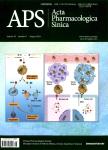Loss of C-terminal α-helix decreased SDF-1α-mediated signaling and chemotaxis without influencing CXCR4 internalization
Loss of C-terminal α-helix decreased SDF-1α-mediated signaling and chemotaxis without influencing CXCR4 internalization作者机构:Department of Clinical Pharmacology Pharmacy School of Ji-nan University Guangzhou 510612 China
出 版 物:《Acta Pharmacologica Sinica》 (中国药理学报(英文版))
年 卷 期:2004年第25卷第2期
页 面:26-34页
核心收录:
学科分类:1007[医学-药学(可授医学、理学学位)] 1006[医学-中西医结合] 100706[医学-药理学] 100602[医学-中西医结合临床] 10[医学]
基 金:Project supported by the National Natural Science Foundation of China (No 30271519 ) Visiting Scholar Foundation of Key Lab of the State Ministry of Education in Chongqing University
主 题:stromal cell-derived factor-1 alpha CXC chemokine receptor 4 chemotaxis
摘 要:AIM: To investigate the possibility that a novel α-helix-defective mutant of stromal cell-derived factor-1α (SDF- 1α) (SDF-1/54R) acts as an antagonist of CXC chemokine receptor 4 (CXCR4). METHODS: According to the genetic sequence of natural SDF-1α, a recombinant α-helix-defective mutant of SDF-1α was designed and some biologic characteristics of this mutant were demonstrated. The migration of Jurkat cells was assessed with chemo- tactic assay. ERK phosphorylation was analyzed by Western blot with a specific anti-phospho-ERK1/2 antibody. Intracellular calcium influx was examined by flow cytometer with a calcium indicator dye Fluo-3AM. The CXCR4 on the cell surface was detected by flow cytometer with a PE conjoined anti-human CXCR4 antibody. RESULTS: Compared with native SDF-1α, SDF-1/54R displayed apparent decrease in chemotactic ability, ERK1/2 activation, and intracellular calcium influx in Jurkat cells. However, the binding to CXCR4 and inducing CXCR4 internalization of SDF-1/54R did not change outstandingly. Moreover, a competitive inhibitory effect of SDF-1/54R on the migration of Jurkat cells induced by native SDF-1α was confirmed. CONCLUSION: α-helix-defective mutant of SDF-1α, SDF-1/54R that remained both the N-terminus and the central β-sheet region, decreased SDF-1α-medi- ated signaling and chemotaxis but did not influence CXCR4 internalization, which suggested that SDF-1/54R might be developed as an anti-CHIV inhibitor with high biological potency and low side-effect.



